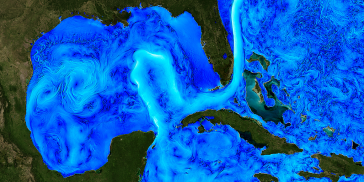URI Graduate School of Oceanography Group Studies the Loop Current

The Loop Current System (LCS), comprised of the Loop Current (LC) and the Loop Current Eddies (LCE) it sheds, is the dominant circulation feature in the Eastern Gulf of Mexico. The position, strength, and structure of the LCS affect a range of natural and human systems including hurricane intensity, oil and gas operations, oil spill response, and the entire Gulf food chain. However, knowledge about the underlying dynamics of the LCS is limited. To improve understanding and prediction of the LCS, Graduate School of Oceanography professors Kathleen Donohue and Randy Watts have deployed an array of instruments on the seafloor as part of a campaign sponsored by the National Academies of Sciences, Engineering, and Medicine.
Return to the Dynamics of Ocean Currents and Fronts Homepage
